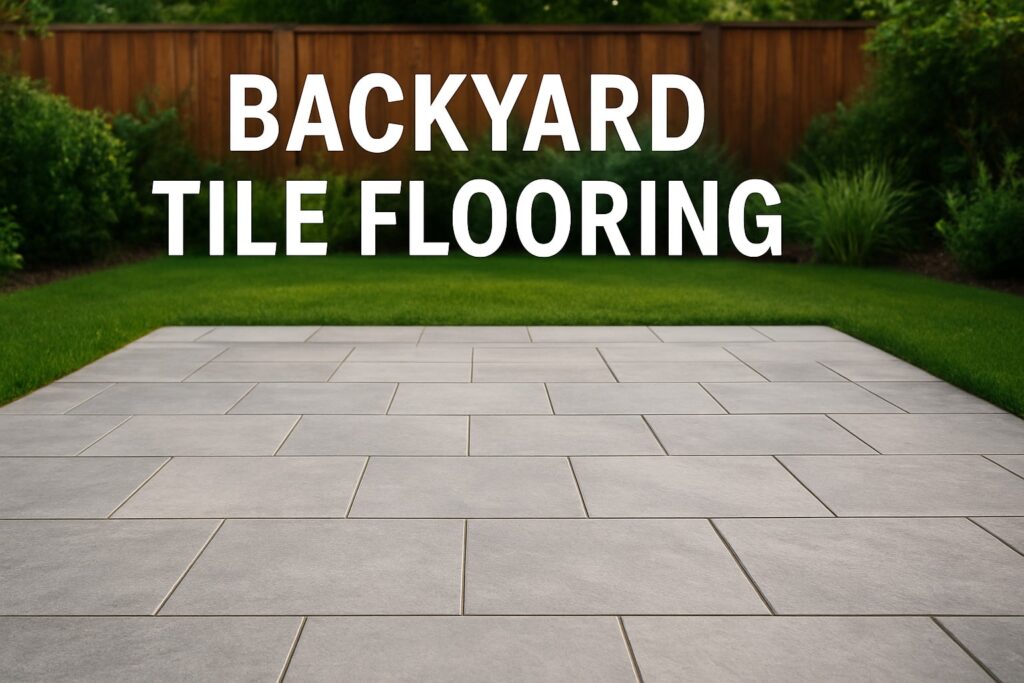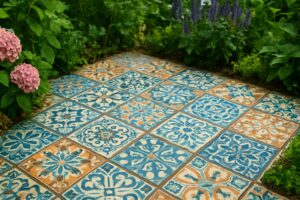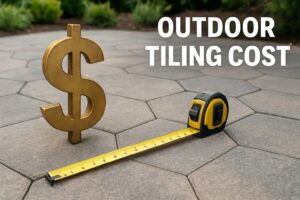Imagine stepping into your outdoor space, greeted by a stunning backyard tile flooring that instantly upgrades your home’s atmosphere. With the right design, your backyard becomes an inviting retreat, easy to maintain and built to last.
This comprehensive 2025 guide will give you the knowledge to choose, plan, and install the ideal backyard tile flooring for your needs. Discover the latest trends, top materials, inspiring designs, installation steps, maintenance tips, and smart budgeting strategies.
Ready to transform your backyard into a luxurious extension of your living space? Let’s explore how you can make it happen, step by step.
Backyard Tile Flooring Trends & Innovations for 2025
Step into the future of backyard tile flooring, where cutting-edge materials, advanced technologies, and thoughtful design converge to create stunning, resilient outdoor spaces. 2025 brings exciting innovations that redefine how we approach style, sustainability, and performance in outdoor environments.
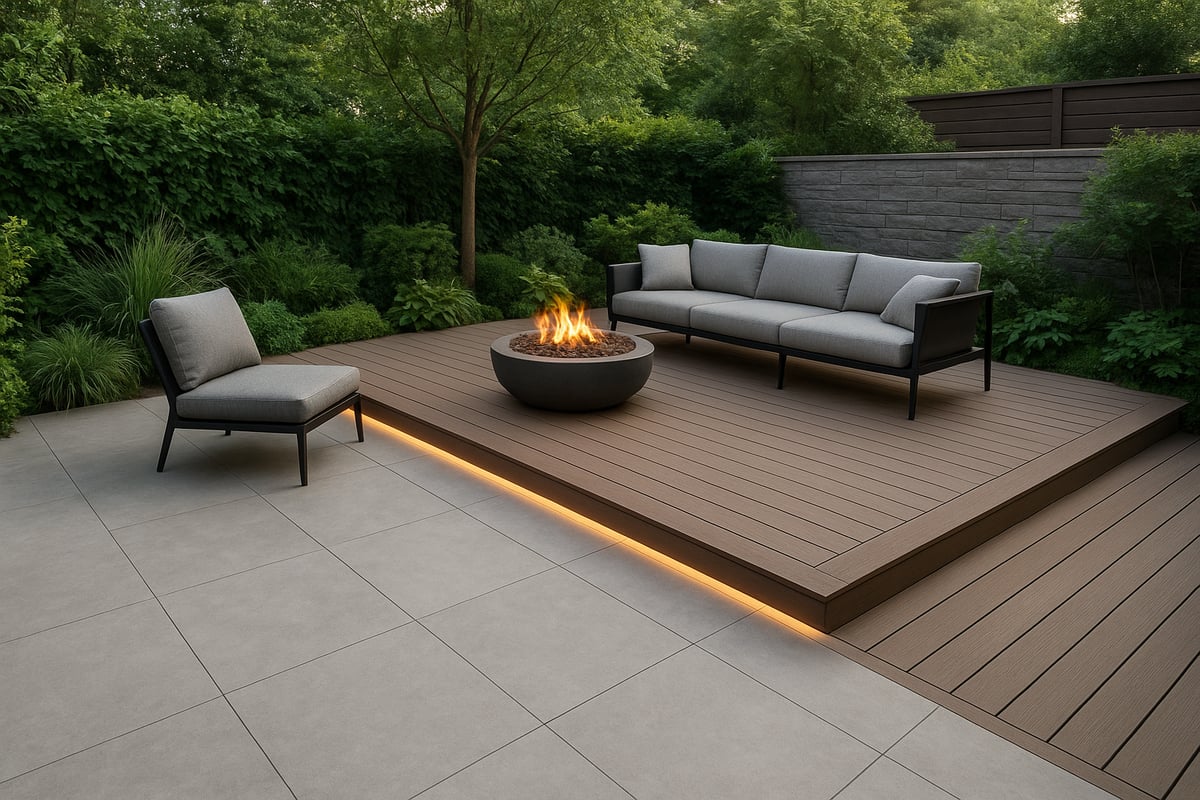
Emerging Materials and Technologies
The landscape of backyard tile flooring is transforming with the arrival of eco-conscious materials and high-performance features. Homeowners are now opting for tiles crafted from recycled porcelain, composite blends, and responsibly sourced ceramics. These options deliver strength and style while minimizing environmental impact.
Technological advances are setting new benchmarks. Slip-resistant and frost-proof surfaces are becoming standard, making backyard tile flooring practical for all climates, including harsh Canadian winters. Smart tile technologies are gaining traction, with integrated LED lighting, under-tile heating, and advanced drainage systems that adapt to changing weather. Weather-adaptive finishes further extend the lifespan of tiles, especially in regions with frequent freeze-thaw cycles.
Modular systems are another game changer, allowing easy customization and hassle-free replacement. This flexibility ensures that backyard tile flooring remains both beautiful and functional, regardless of shifting trends or homeowner needs.
Design Trends Shaping Outdoor Spaces
Aesthetically, backyard tile flooring in 2025 is all about blending natural inspiration with modern sophistication. Large-format tiles are in demand for creating seamless, visually expansive surfaces that evoke a sense of luxury. Natural stone looks, such as travertine, slate, and marble-inspired porcelain, offer timeless appeal with the added benefit of durability.
Wood-look tiles are bridging the gap between rustic charm and weather resistance, providing the warmth of wood without the upkeep. Pattern play is also shaping outdoor spaces, with herringbone, chevron, and geometric layouts introducing dynamic movement and visual intrigue.
Color palettes are evolving to include earthy neutrals, bold accent shades, and biophilic greens, encouraging harmony with surrounding landscapes. This thoughtful approach ensures backyard tile flooring harmonizes with both architecture and nature.
Sustainability and Wellness Considerations
Sustainability is a cornerstone of backyard tile flooring trends in 2025. Low-VOC and toxin-free tile options are increasingly available, supporting healthier outdoor environments. Permeable tile systems are gaining popularity as they improve drainage, reduce runoff, and contribute to eco-friendly landscaping.
Some tile products are even designed to support urban biodiversity, incorporating features that allow for plant growth between tiles or encourage pollinator habitats. This holistic focus on wellness and environmental responsibility ensures that backyard tile flooring not only looks beautiful but also promotes a healthier ecosystem.
Data & Insights
The backyard tile flooring market is experiencing robust growth, fueled by innovation and evolving homeowner priorities. According to industry reports, demand for outdoor porcelain tiles is projected to increase by 7% annually through 2025. Durability and easy maintenance top the list of what homeowners want in outdoor flooring, as highlighted by a recent Houzz survey.
For those seeking further details on the trends and technologies shaping the industry, the Outdoor Flooring Trends for 2025 article provides valuable insights into materials, design directions, and sustainability initiatives.
These developments empower homeowners to make informed decisions about backyard tile flooring, ensuring every project delivers both style and substance.
Choosing the Right Tile Flooring for Your Backyard
Selecting the ideal backyard tile flooring is a process that blends practicality, safety, design, and value. Each decision shapes the comfort, functionality, and beauty of your outdoor space for years to come. Let's break down the essential steps to ensure your backyard tile flooring project is a lasting success.
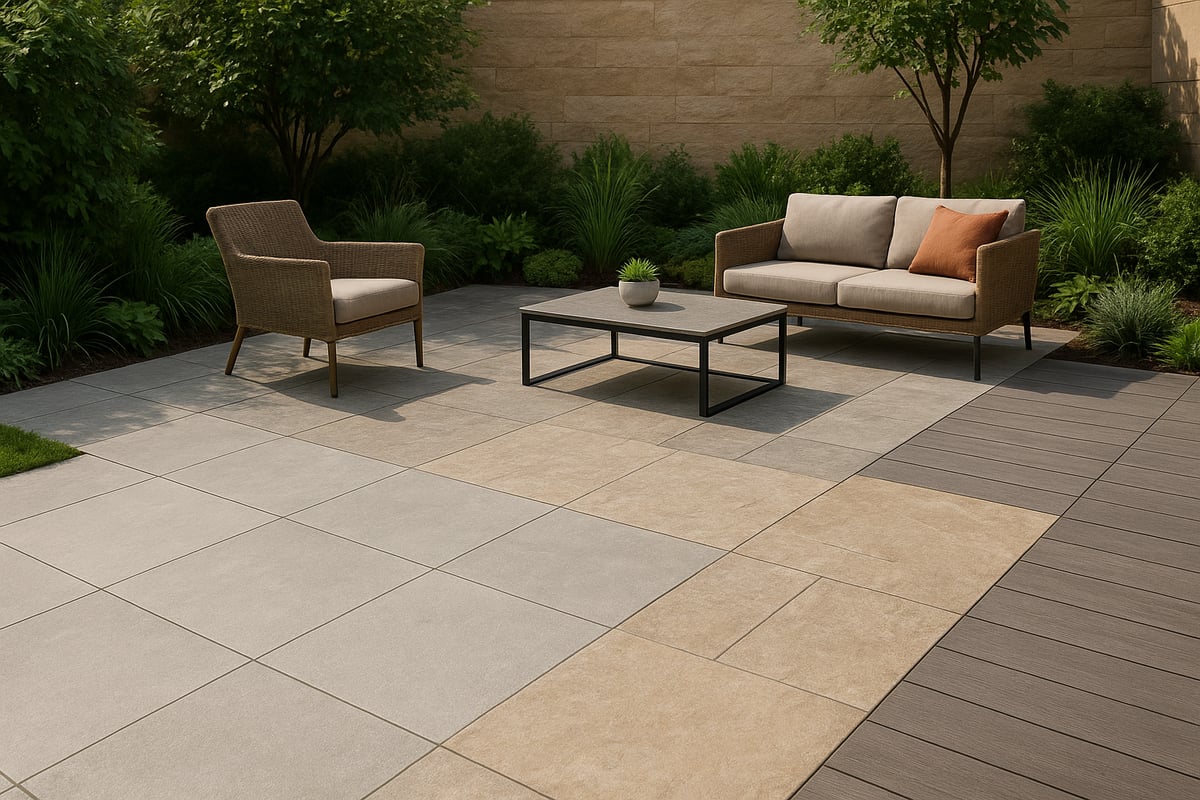
Assessing Your Outdoor Space & Needs
Begin by thoroughly evaluating your outdoor area. Consider the local climate, sunlight exposure, and how much moisture your backyard tile flooring will face. In regions with freeze-thaw cycles, choosing frost-proof tiles is essential.
Think about your existing landscaping, outdoor furniture, and how you plan to use the space. Will it see heavy foot traffic, host gatherings, or surround a pool? These factors determine the performance requirements for backyard tile flooring.
Finally, assess load-bearing needs. For patios, decks, or pool surrounds, ensure the substructure can support the chosen tile material's weight. This groundwork ensures your backyard tile flooring stands the test of time.
Tile Material Comparisons
The material you select for backyard tile flooring dramatically affects longevity, appearance, and maintenance. Here is a quick comparison:
| Material | Pros | Cons |
|---|---|---|
| Porcelain | Durable, low maintenance, versatile | Heavier, can be pricier |
| Natural Stone | Unique beauty, natural texture | Higher maintenance, costly |
| Composite Tiles | Eco-friendly, fade resistant | May lack authentic texture |
| Concrete Tiles | Affordable, customizable, slip-safe | Limited design variety |
| Wood-Look Tiles | Warmth of wood, weather resistant | Quality varies by brand |
For more inspiration and guidance on material selection, explore these deck and patio flooring ideas. With so many choices, you can tailor your backyard tile flooring to fit both your lifestyle and regional needs.
Safety, Comfort, and Compliance
Safety is a top priority when installing backyard tile flooring, especially in areas near pools or play zones. Slip-resistant surfaces help prevent accidents, while tiles designed to stay cool underfoot add comfort during hot summer days.
Check local building codes, HOA, or condo regulations before choosing your backyard tile flooring. Compliance ensures your project meets all safety and structural standards, preventing costly modifications later.
Prioritizing comfort with the right tile surface and proper installation techniques will make your outdoor space both enjoyable and accessible for everyone.
Aesthetic Considerations
Aesthetics play a vital role in how your backyard tile flooring enhances your home's architecture and landscape. Match tile styles with your house exterior and garden design for a cohesive look.
Experiment with colors, textures, and patterns. Large-format tiles create a sleek, modern effect, while patterns like herringbone or chevron add dynamic visual interest. Consider creating distinct zones by mixing tile types or layouts, which adds both function and beauty to your backyard tile flooring.
Take time to visualize how your selections will look with outdoor lighting and greenery for a truly inviting atmosphere.
Budgeting and Value
Setting a realistic budget for backyard tile flooring means understanding both upfront and long-term costs. Porcelain tiles typically range from $8–$20 per square foot, while composite options run $6–$15 per square foot.
Factor in durability, warranties, and maintenance savings over time. A higher initial investment in quality backyard tile flooring often pays off with fewer repairs and longer life.
Consider phased installation, DIY approaches, or shopping during seasonal promotions to maximize your value. Every dollar spent wisely brings you closer to a luxurious, low-maintenance outdoor retreat.
Skyscapes Urban Balcony Flooring
For homeowners seeking premium backyard tile flooring solutions, Skyscapes Urban Balcony Flooring offers a curated range of luxury outdoor tiles. Their products, including porcelain, composite, and exotic hardwood options, are engineered for Canadian climates and designed to be slip-resistant and frost-proof.
Skyscapes provides full-service support, from design consultation to professional installation, and backs every product with a 15-year warranty. Their expertise ensures your backyard tile flooring project meets all building codes and delivers a rapid, high-end transformation.
Choosing a reputable provider like Skyscapes guarantees long-lasting, beautiful results for patios, balconies, or rooftop spaces.
Planning & Designing Your Backyard Tile Flooring Project
A well-thought-out plan is the foundation of any successful backyard tile flooring project. By carefully considering each design and preparation step, you can create an outdoor space that is both beautiful and functional. Let’s break down the planning and design process to help you achieve the perfect result.
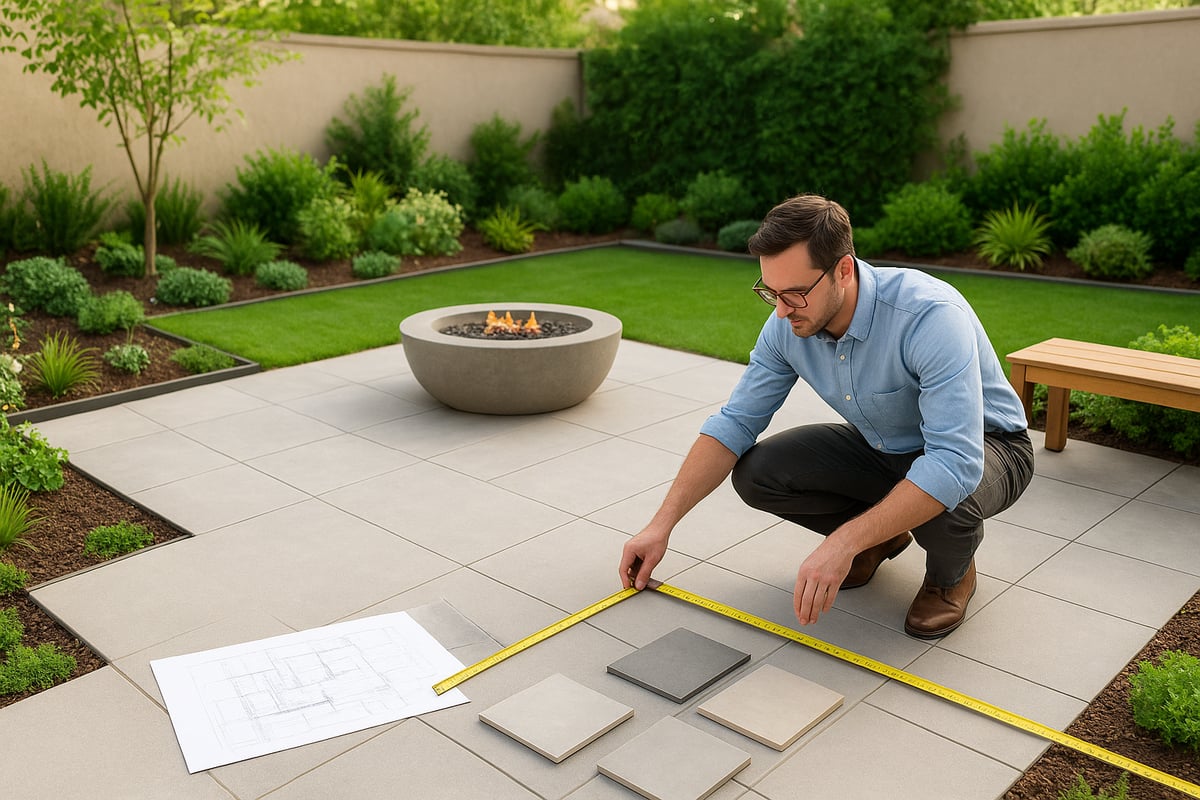
Site Preparation and Layout Planning
Start by measuring your outdoor area with precision. Account for slopes to ensure proper drainage, and identify whether your substrate is soil, concrete, deck, or rooftop. Each surface type will determine the specific installation requirements for your backyard tile flooring.
Check for existing obstacles, such as trees or posts, and plan your layout to work around them. Expansion joints and adequate tile spacing are essential for long-term durability, especially in climates with temperature fluctuations.
Before moving forward, sketch out your space and mark zones for different activities. This helps visualize how the backyard tile flooring will function in daily life.
Design Tools and Visualization
Leverage digital tools to bring your vision to life. Online design platforms and augmented reality apps let you experiment with patterns, colors, and tile sizes before committing. These resources make it easy to see how porcelain or composite tiles will look in your unique setting.
For more personalized results, consult a design professional. They can offer insights into the latest trends and recommend materials that fit your lifestyle. For a deeper dive into porcelain options, the Outdoor Porcelain Decking Guide provides inspiration and practical advice tailored for backyard tile flooring projects.
Gather tile samples and create mood boards to test how different textures and finishes complement your existing outdoor décor.
Integration with Landscaping and Outdoor Features
A cohesive outdoor design blends tile flooring with the natural landscape. Choose colors and finishes that coordinate with your plants, lighting, and water features to establish visual harmony.
Consider seamless transitions between indoor and outdoor spaces. For example, matching tile styles or using similar color palettes can make your backyard tile flooring feel like an extension of your home.
Don’t forget to plan zones for outdoor kitchens, fire pits, or lounge areas. These features can be highlighted with different tile layouts or accent borders.
Accessibility and Comfort
Prioritize accessibility from the start. Smooth transitions between your home and backyard tile flooring are vital for safety and mobility, especially if you have children or elderly family members.
If you live in a cooler climate, explore under-tile heating or insulation options. These additions can extend the usability of your outdoor space throughout the year and make it more comfortable underfoot.
Select tile surfaces that stay cool in the sun and offer slip resistance, particularly around pools or play zones.
Permits and Approvals
Before installation, review local building codes, HOA guidelines, or condo board rules. Some regions require permits for backyard tile flooring projects, especially if drainage or structural changes are involved.
Prepare a checklist of documents and approvals needed. Early communication with authorities can prevent costly delays and ensure your project meets safety and compliance standards.
If you’re hiring contractors, confirm that they are familiar with local regulations for outdoor tile installations.
Real-World Examples
Consider real-life transformations for inspiration. In Toronto, a homeowner revitalized their outdoor space with large-format porcelain tiles and integrated LED lighting, creating a modern and inviting backyard.
Before-and-after photos can help you visualize the dramatic impact of well-planned backyard tile flooring. Look for case studies that showcase different materials, layouts, and combinations with landscaping elements.
Draw on these examples to refine your own vision and set realistic expectations for your project.
Step-by-Step Installation Guide for Backyard Tile Flooring
Transforming your outdoor space with backyard tile flooring is a rewarding project that adds both style and function. Whether you are upgrading a patio, deck, or rooftop, following a step-by-step process ensures a durable and beautiful result. Let’s break down each stage to simplify your installation journey.
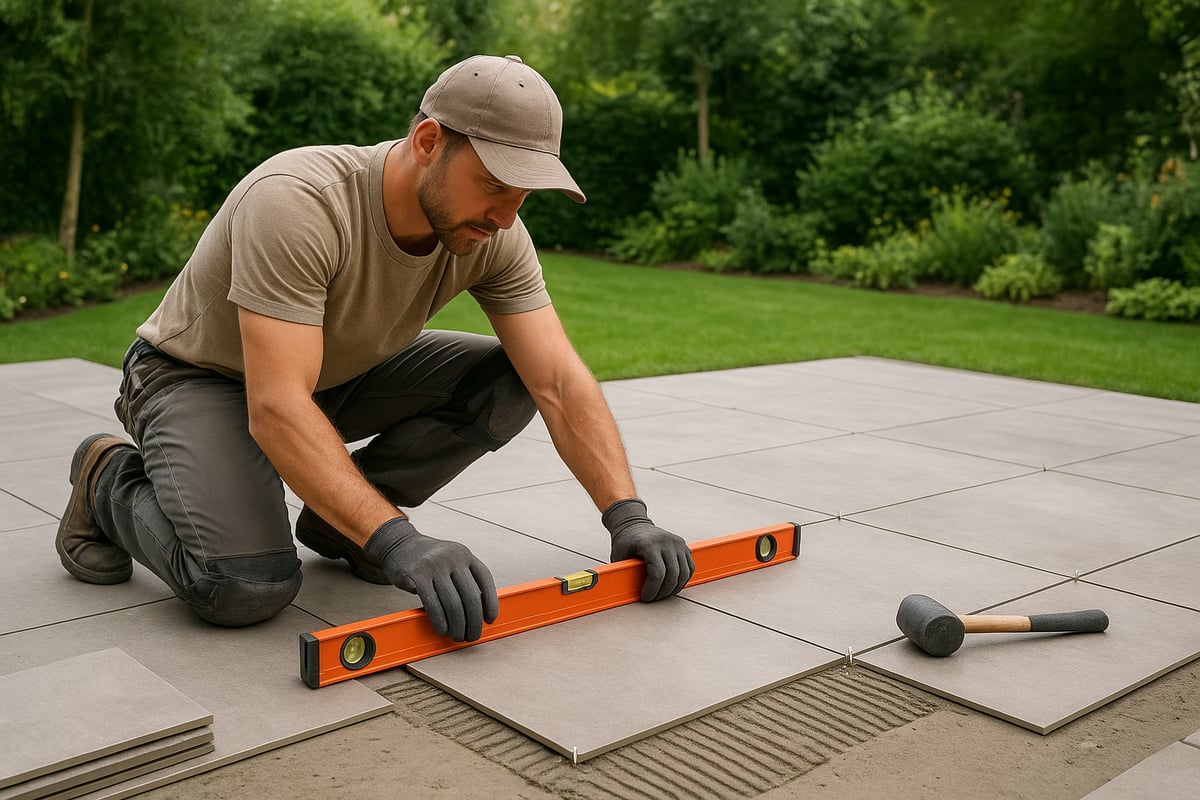
Step 1: Preparing the Groundwork
A successful backyard tile flooring project starts with a solid foundation. Begin by clearing the area of any debris, old materials, or vegetation. Next, level the surface to prevent future shifting or water pooling. Use a compactor for soil bases, or ensure concrete slabs are free of cracks and slopes toward drains.
Proper drainage is essential for backyard tile flooring longevity. Install a drainage layer or membrane if needed. Waterproof underlayments are recommended, especially for rooftop or balcony installations. For more expert guidance, check out these Tips for Successful Outdoor Tile Installation.
Step 2: Selecting and Ordering Materials
Choose materials compatible with your climate and the intended use of your backyard tile flooring. Calculate the required tile quantity, including an extra 10 percent for cuts and breakage. Select adhesives, grouts, and spacers rated for exterior applications.
Order all materials in advance to avoid project delays. Schedule delivery for a time when you can inspect products for damage or defects. This preparation step ensures a smooth start for your backyard tile flooring installation.
Step 3: Laying the Tiles
Begin by dry-laying your tiles to finalize the pattern and alignment. This allows you to visualize the layout and make any necessary adjustments before permanent placement. Apply adhesive using a notched trowel for even coverage.
Set each tile with care, using spacers to maintain consistent joints. Regularly check for levelness as you progress. For floating backyard tile flooring systems, such as interlocking tiles, follow the manufacturer’s pedestal or connector instructions.
Step 4: Cutting and Fitting
Precision is key when cutting tiles for edges, corners, or around obstacles like posts and drains. Use a wet saw or tile cutter designed for your tile material. Always wear safety gear to protect your hands and eyes.
Measure twice before making any cuts. Dry-fit pieces to ensure a snug fit before fixing them in place. This careful approach ensures your backyard tile flooring looks polished and professional.
Step 5: Grouting and Sealing
Select an outdoor-rated, weatherproof grout that matches your tile color and resists moisture. After tiles are set, apply grout with a rubber float, pressing it firmly into joints. Wipe off excess grout with a damp sponge before it hardens.
Allow grout to cure as per manufacturer instructions. If your tiles or grout require sealing, apply a quality sealant to enhance durability and stain resistance. This step protects your backyard tile flooring from the elements.
Step 6: Finishing Touches
Add trim or edge pieces to create a clean transition between your backyard tile flooring and adjacent surfaces. Install borders or accent strips if your design includes them. Consider adding outdoor accessories like planters, LED lighting, or rugs for extra comfort and style.
Inspect the finished area for any gaps or uneven spots. Make necessary adjustments for a flawless look. These details elevate your backyard tile flooring project from functional to fantastic.
Step 7: Curing and First Use
Let your new backyard tile flooring cure fully before heavy use. This period allows adhesives and grout to achieve maximum strength. Avoid moving furniture or placing heavy objects on the surface until the recommended curing time has passed.
For initial cleaning, use a soft broom and mild detergent. Avoid harsh chemicals that could damage tiles or grout. Proper first steps set the stage for long-term beauty and performance.
Professional vs. DIY Installation
Deciding between DIY and professional installation depends on your skills, project size, and time constraints. DIY can save money, especially for smaller or modular backyard tile flooring projects. However, complex layouts or challenging substrates may require a professional for optimal results.
Professionals bring expertise, specialized tools, and warranty coverage that DIY projects may lack. Evaluate your comfort level and project scope before making a choice. Quality installation is crucial for lasting backyard tile flooring satisfaction.
Maintenance & Longevity: Keeping Your Outdoor Tile Floor Beautiful
Preserving the beauty and performance of your backyard tile flooring is essential for maximizing your investment. With the right care routine, your outdoor tiles can remain vibrant and functional for years, regardless of climate or daily use. Let us explore the best practices to keep your space looking its best.
Routine Cleaning and Upkeep
Regular cleaning is the foundation of maintaining backyard tile flooring. Sweep or blow away leaves and debris weekly to prevent buildup. For deeper cleaning, use a mild detergent mixed with water and a soft-bristle brush. Avoid harsh chemicals, as they can degrade tile finishes over time.
Promptly address spills to prevent staining, especially on porous tiles. Mold and mildew can develop in damp conditions, so check shaded or covered areas regularly. Power washing is effective for most tile types, but always consult manufacturer guidelines to protect your backyard tile flooring from damage.
Seasonal Care
Seasonal changes can impact backyard tile flooring, especially in regions with harsh winters or intense summer heat. As winter approaches, seal any porous tiles and cover exposed areas to prevent freeze-thaw cycles from causing cracks. Remove snow promptly with a plastic shovel to avoid scratching surfaces.
During summer, monitor for fading or heat damage. Position outdoor rugs or furniture to shield tiles from direct sunlight, which helps retain color vibrancy. Consistent seasonal care ensures your backyard tile flooring withstands weather extremes while maintaining its appeal.
Repair and Replacement
Even with diligent care, tiles may eventually crack or loosen. Swiftly repairing damaged sections prevents issues from spreading. For modular systems, such as those highlighted in Composite Deck Tile Solutions, replacing individual tiles is straightforward and minimizes disruption.
Inspect grout lines and edges regularly for signs of wear. Prompt repairs extend the lifespan of your backyard tile flooring and maintain a seamless, attractive surface for outdoor enjoyment.
Maximizing Lifespan
Proper installation is key to the longevity of backyard tile flooring. Quality adhesives, correct spacing, and professional techniques all contribute to durability. Consider professional services like those offered by Outdoor Flooring Installation Services for expert installation and access to extended warranties.
Routine inspections and timely maintenance are equally important. Investing in premium materials and proper care delivers long-term value and preserves the beauty of your backyard tile flooring for decades.
Data & Tips
Porcelain and composite tiles are renowned for their durability, with typical lifespans ranging from 15 to 25 years under proper care. Industry estimates suggest that regular maintenance can extend tile life by up to 30 percent, making it a wise investment.
Use the table below for a quick maintenance summary:
| Task | Frequency | Notes |
|---|---|---|
| Sweeping | Weekly | Prevents debris buildup |
| Deep Cleaning | Monthly | Use mild detergent |
| Sealing | Annually (if needed) | For porous tile types |
| Inspection/Repairs | Biannually | Address cracks promptly |
Consistent attention keeps your backyard tile flooring looking fresh, functional, and ready for every season.
Budgeting, Cost Factors, and ROI for Backyard Tile Flooring
Careful planning is essential when considering backyard tile flooring. Understanding the full cost picture helps homeowners make informed decisions and maximize their investment. Let’s break down the main factors that influence your budget and the long-term value you can expect.
Upfront Costs and Installation Fees
The upfront cost of backyard tile flooring varies based on tile material, design complexity, and site preparation. Material prices range widely: porcelain tiles typically cost $8 to $20 per square foot, while composite options are $6 to $15 per square foot. Labor fees depend on the installation method, project size, and substrate condition.
Accessories such as adhesives, grout, trim, and underlayments add to the total. If you are considering a professional installation, expect higher labor costs but also a higher-quality finish. For those interested in best practices, reviewing Modern Installation Methods for Pavers can help you understand what goes into a durable, long-lasting installation. Site complexity, such as sloped yards or existing landscaping, may increase preparation expenses.
Long-Term Value and Savings
Investing in backyard tile flooring pays off over time. Unlike wood decks or plain concrete, quality tile requires less maintenance, reducing annual upkeep costs. Most outdoor tiles are engineered for durability, with many lasting 15 to 25 years or longer.
Another benefit is the boost in property value. According to Remodeling Magazine 2024, attractive outdoor living spaces like tiled patios can increase home resale value by 10 to 15 percent. Homeowners who prioritize low-maintenance solutions often realize significant savings over the lifespan of their backyard tile flooring.
Financing and Incentives
Budgeting for backyard tile flooring is easier with flexible payment options. Many suppliers and contractors offer payment plans or partner with lenders to provide home improvement loans. Seasonal discounts are common during off-peak months, allowing homeowners to save on both materials and installation.
Eco-friendly or permeable tile systems might also qualify for local government rebates. These incentives can reduce the upfront investment and make sustainable choices more accessible for a wider range of budgets. Always check with your local municipality for current programs before starting your project.
Cost-Saving Tips
There are several ways to lower the cost of backyard tile flooring. DIY installation can save on labor for smaller spaces, especially when using modular or portable tiles. For step-by-step guidance, consult resources like How to Install Portable Outdoor Tiles. Buying materials in bulk or during sales, and phasing your project over time, can also help keep expenses in check.
Case Studies & Real-World Examples
Homeowners in Ontario saved 20 percent on backyard tile flooring by selecting composite tiles and spreading installation across two seasons. Over a decade, tile flooring often outperforms traditional decking in both longevity and return on investment. Comparing costs side by side reveals that the initial investment is offset by reduced maintenance and increased property value.

